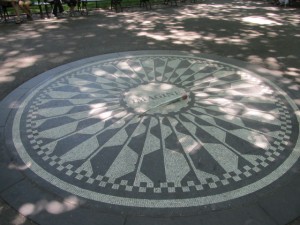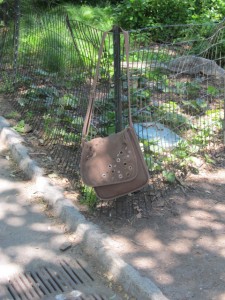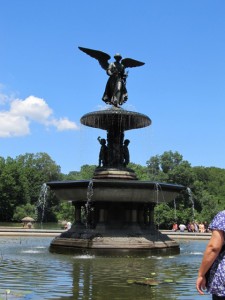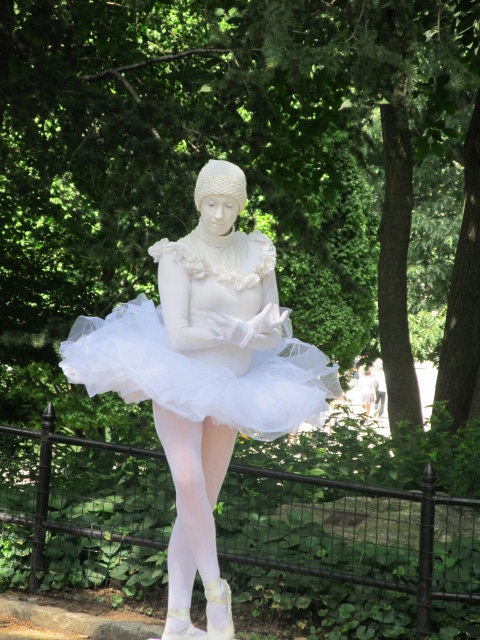July 1, 2011
Wednesday
The most unusual and surrealistic place in New York City is Central Park.
        — Christo (Christo Vladamirov Javacheff), b. 1935
Bulgarian artist
To prepare for my month in New York City, the summer I named “Eat — Pray — Walk,” I acquired New York Walks (Second Edition), a guide book authored by Jane Egginton and Nick O’Donnell. It outlined fourteen walks around the city that would give the tourist a more or less complete tour of Manhattan, including the waterfront, SoHo, the East Village, the downtown skyscrapers, the museums, and, of course, Central Park.
In my various trips to New York over my life (I have counted a dozen, beginning with a family vacation when I was ten years old), I have not spent much time in the park. Despite the fact that it borders the Metropolitan Museum of Art, which I have visited several times, I’m not sure I ever even entered it until February of 2005, when I went there specifically to see The Gates, Christo and Jeanne-Claude’s installation of orange flags throughout the park. I was in a Slough of Despond when I arrived that day, a different person when I left, and I carry in my calendar book a swatch of that orange fabric, to remind me how, as I wrote a few months later, “I looked at those flags . . . and saw [Lynn’s] smile in them, saw her spirit in their flutter, in their dance with the wind. Something in me lifted. Something in me said, you can rise above whatever darkness is holding you back.”
I began today’s “landscaped ramble” at 72nd Street and Central Park West. That is the location of The Dakota, the co-op apartment building that is almost a character in the novel and movie Rosemary’s Baby, and is the place where John Lennon was murdered, in the courtyard, as he was returning home on December 3, 1980. The Strawberry Fields memorial is just inside the park, and that’s where I began my walk.
 This is the “Imagine” mosaic that is a great tourist draw. In order to get this picture, I had to wait while a number of other tourists knelt, placed their flowers, posed for pictures. I heard people whispering about whether it was okay to walk across the piece. John Lennon is not buried there, of course. He was cremated, and his ashes were returned to Yoko Ono, and what she did with them is not verified, and nobody’s business anyway. I suspect, though, that she did not scatter them in Central Park.
This is the “Imagine” mosaic that is a great tourist draw. In order to get this picture, I had to wait while a number of other tourists knelt, placed their flowers, posed for pictures. I heard people whispering about whether it was okay to walk across the piece. John Lennon is not buried there, of course. He was cremated, and his ashes were returned to Yoko Ono, and what she did with them is not verified, and nobody’s business anyway. I suspect, though, that she did not scatter them in Central Park.
I walked past a number of monuments, including a statue of Daniel Webster. “This is not the dictionary maker,” I heard a tour guide, whose first language was not English, say. “That was Noah Webster. Always much confusion.” Daniel Webster, 1782-1852, was, among other notable accomplishments, Secretary of State under William Henry Harrison (my favorite president!), and John Tyler and Millard Fillmore as well.
 I stopped at the bottom of the hill below the Daniel Webster monument to consult my map, ready to go in search of Wagner Cove, described in my guidebook as a “hidden oasis.” There was an information kiosk (not staffed) there, and a number of people trying to get their bearings as well. There was also a construction fence keeping visitors away from a rocky precipice. Presently, a woman sitting near me said, “Does that purse belong to anyone here?”
I stopped at the bottom of the hill below the Daniel Webster monument to consult my map, ready to go in search of Wagner Cove, described in my guidebook as a “hidden oasis.” There was an information kiosk (not staffed) there, and a number of people trying to get their bearings as well. There was also a construction fence keeping visitors away from a rocky precipice. Presently, a woman sitting near me said, “Does that purse belong to anyone here?”
It was an ordinary woman’s shoulder bag, obviously full of the things women carry, even on a “landscaped ramble” in a famous park. No one acknowledged the bag. “I’ve been here ten minutes,” said the woman who had called for everyone’s attention. “That bag was there when I sat down.”
The kiosk had one of the “If you see something, say something” posters that you see around town, on the subway platforms, in the buses, on utility poles. Unattended packages are to be treated with some suspicion. The woman got out her phone. I read her the number for security on my Central Park brochure.
Evidently our concern was taken seriously. “They said don’t touch it, don’t go near it. They’re sending someone,” the woman reported. I didn’t hang around to see if a bomb squad arrived.
 Instead, I continued on the walk as laid out in my guide book. The Bethesda Fountain made my 19th-century scholar’s heart beat a little faster. The Angel of the Waters, an 8-foot bronze figure, was designed by Emma Stebbins, the first woman to receive a commission for a major work of art in the city of New York. The terrace that it is part of was a joy to walk through and take pictures in. (And it had a clean, functioning bathroom!)
Instead, I continued on the walk as laid out in my guide book. The Bethesda Fountain made my 19th-century scholar’s heart beat a little faster. The Angel of the Waters, an 8-foot bronze figure, was designed by Emma Stebbins, the first woman to receive a commission for a major work of art in the city of New York. The terrace that it is part of was a joy to walk through and take pictures in. (And it had a clean, functioning bathroom!)
The best part of my visit to the Bethesda Terrace was the performance of a trio of young musicians, Dom, Julia, and Meredith. They were, evidently, playing there against recent regulations imposed by the park administration. Eight areas have been designated “quiet zones,” including Strawberry Fields and the Bethesda colonnade. Musicians have been ticketed and even arrested for continuing to perform.
I listened to Dom, Julia, and Meredith for about a half hour. I was especially drawn to Meredith, on the violin. What if, I wondered, I had defied my mother in 1967, taken the opportunity to attend NYU and study social work that my advisor at Harrisburg Area Community College had recommended me for. I could have helped support myself as a street musician. It would have been an ironic use of the violin lessons my mother had imposed upon me.
By the time Dom, Julia, and Meredith were ready to take a break, I had been in the park for a little more than three hours. The guidebook had another five or six attractions to see, plus it suggested ending with a visit to the American Museum of Natural History. Really? You’re supposed to just stroll into probably the largest, most complex museum in the city after rambling several miles through the park?
I exited at 72nd Street and 5th Avenue. The last thing I saw was Therisa Barber-Shaw, a “ballerinamime” who is available for “events, promotions, and all fields of entertainment.” She was just setting up her box when I got there. She had a basket, as does any street performer, with a sign suggesting that it was impolite to take a picture without making some kind of contribution.
I watched her through several poses, and I put some bills in the basket when I left. She bowed, and smiled.
